Text
17 Charts That Show Where Content Marketing is Heading
I started content marketing in the early days. So early that when I first met the WordPress founder, he had just raised $1.1 million for WordPress.
Fast forward to today and WordPress is worth over a billion dollars.
Similarly, when I first started with content marketing, there were less than 30 million blogs that existed and now there are over a billion.
In other words, things have changed drastically and now it’s what more competitive.
We are at a point where you already know you need to leverage content marketing. But what areas of content marketing should you focus on?
How many blog posts do you need to write? What are the best ways to monetize your traffic?
How can you ensure that what you are doing will work in the future?
To shed some light on where content marketing is headed, I’ve gathered data from 183 companies who are all leveraging content marketing. Each company makes at least 5 million dollars in revenue a year and generates less than $1.9 billion a year.
These companies are in all different sectors, from B2B to B2C, and are part of all the major industries out there. Most importantly, they have been leveraging content marketing for at least 8 years.
Now, I know many of you don’t have a company that generates at least 5 million dollars a year, but the stats and data I will show you are still relevant to your blog.
So, let’s dive into the stats to see where content marketing is headed.
Expect less traffic from social sites
What do you think has happened to social shares over time?
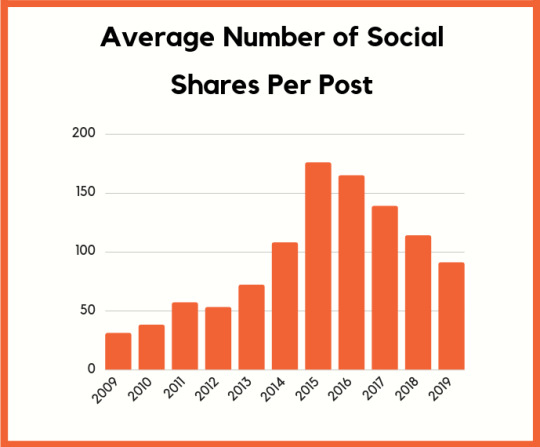
As you probably guessed, social shares have gone down because the algorithms (like on Facebook) really limit organic reach.
In the early days, people saw big lifts in their social share count due to the fact that these social sites were still growing in popularity. But once their growth slowed down, so did the number of times the shares each piece of content generated.
If you are wondering why just think of it this way… when people share content on social sites it drives users off of the platform. By keeping people on Facebook longer (or any other social platform), they make more money as people click on ads.
If you are expecting to grow your blog through the social web, think again. It’s slowly driving less and less traffic each year and you should expect it to get worse.
You need to take an omnichannel approach, but focus on search
Can you guess what’s the most popular traffic channel for a blog?

SEO made up 51% of the blog’s traffic and to no surprise, social media was the 5th most popular channel.
But what was surprising is that referral traffic was in 3rd place at 11% and email was at 9%.
Instead of just focusing on link building to boost your rankings, you should focus on link building to also increase your referral traffic. In essence, you can get more bang for your buck by increasing two different ways to drive traffic with one strategy.
Whether it is guest posting or generating PR, you should try and get as much referral traffic as possible as it creates steady traffic that isn’t too affected by algorithm updates.
As for email, you may think it’s dead, but it’s alive and kicking strong. Remember, everyone who works in the corporate world still uses email.
Don’t be shy about collecting emails. You can use tools like Hello Bar to do this with ease.
Now going back to SEO for a moment… here’s why you have to blog.
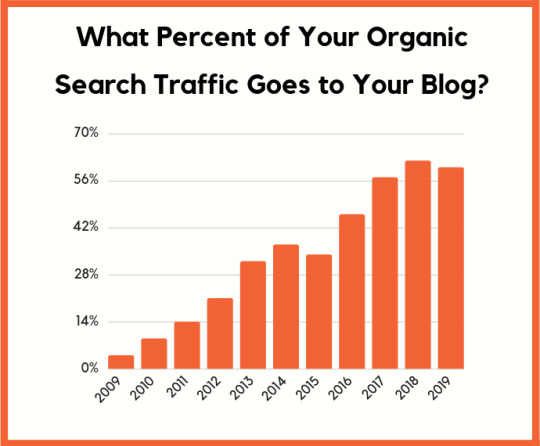
As you can see from the graph above, Google has continually shifted from ranking web pages to pushing up content over time. And it doesn’t look like that the trend is stopping anytime soon.
Blogs are generating, on average, 60 to 62 percent of a site’s search traffic. Sure, it’s going to be different for the Amazon’s of the world, but you aren’t them… and neither am I.
SEO is also getting more competitive because there are more blogs popping up and people are creating tons of content. But you have no choice but to do the same if you want to keep up.
You need to build a content marketing team…
Well, just look at it this way…
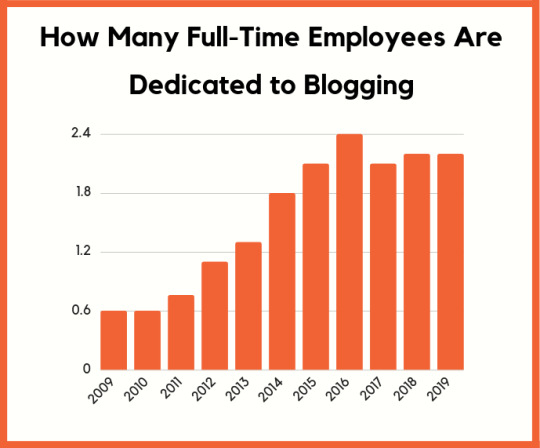
On average, mid-sized companies now have at least 2 full-time employees managing their blog. It’s because they know content marketing isn’t going anywhere without putting in real effort and you need to take it seriously if you want to grow fast.
And on top of having dedicated employees, the average mid-sized company has a bit more than 10 contractors working on their blog.

Now, I don’t want you to get scared by that number as a lot of those contractors are writing content. They are not working full time… it’s as simple as some of them writing only a handful of content pieces a month.
Or it could be as simple as them helping you produce video content or create infographics.
With your blog, you should consider hiring more contractors as writers instead of hiring full-time employees as it is cheaper.
It’s also more efficient to have contractors as you can scale up and down faster. On top of that, you’ll find that you will save money in the long run as contractors and consultant tends to be cheaper than full-time employees.
You need to write on average 5.7 articles a week
Out of the 183 blogs we talked to, they publish 22.8 pieces of content per month on average.

And can you guess how long each of them is?

Well, they say that if you want to rank on page 1, you need to write content that is 1,890 words.
Most of the blogs we analyzed and talked to all followed one common theme… as time went on, they started writing longer posts.
They are now averaging 2,118 words per post. In 2016 that number peaked out at 2,381 words because people started producing in-depth guides, which caused that number to spike.
But what they found over time is that writing content that is too in-depth, such as guides, doesn’t necessarily guarantee higher rankings.
To give you an idea, years ago I wrote a 30,000-word guide on SEO. Can you guess what page it ranks on for the term SEO?
It ranks on page 2.
Now, this guide to SEO is much shorter and ranks on page 1.

In other words, it is better for you to create more content than it is to create one super long blog post.
Think of your content as fishing hooks. If you have more fishing hooks out, there is a greater chance of catching a fish.
The same goes with blogging, the more content you create (assuming it is high quality), the higher the chance you’ll have of attracting more visitors.

Think of your blog as a funnel.
At the top of the funnel, you want to attract as many people as possible. The more people you attract, the more revenue you’ll eventually end up generating.
As you can see from the graph above, 24% of customers first found out about the company through their blog.
Now, that doesn’t mean they converted into a customer right when they landed on the blog for the first time. More so, they learned about the company first through their blog.
Not only do search engines love blogs, so do people. And the trend is continually rising over time.
Blog readers will boost your conversion rate
When someone reads your blog, it builds trust and causes your conversion rate to increase.

The graph above shows how someone who reads your blog is 74% more likely to convert into a customer compared to someone who hasn’t read your blog.
Advertising is only getting more expensive each year. By blogging more frequently, you can boost your conversion rates.
But don’t expect people to convert right away when they read your blog.
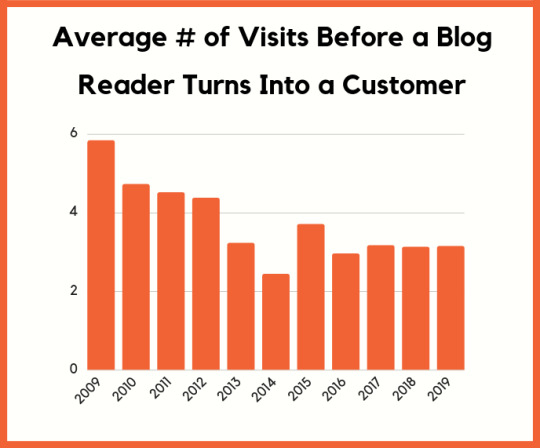
The average number of times someone needs to come back to your blog before they convert is 3.15 times and they tend to convert over a 2-week period of time.
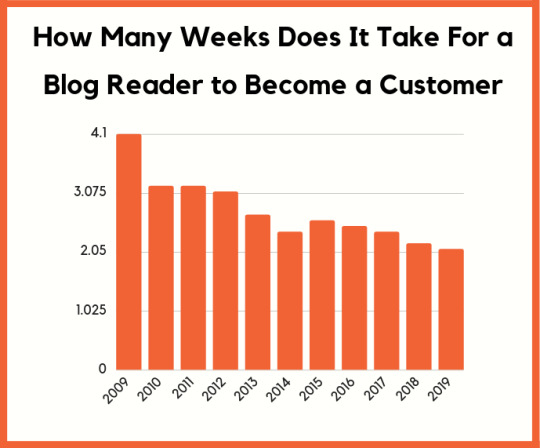
Now, you’ll also find that as you create content people don’t just open up their wallets and give you their money. You need to push them to convert.
The trend we saw is that blogs are leveraging more methods than ever to convert visitors into customers.
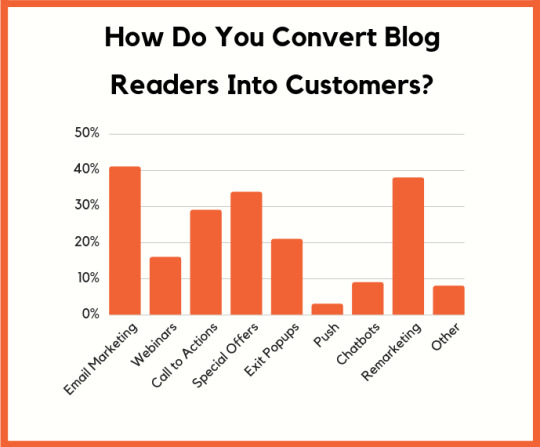
Email marketing is the main method bloggers are using, which isn’t a surprise. But the number 2 method is remarketing.
When I dug into it, these companies on average spend $51,409 a month on paid ads. And each year they saw their ad costs drastically increase. But what’s helped reduce their blended CPA is remarketing all of their blog readers.
In the coming years, remarketing will overtake email as the main way companies are converting readers into customers.
You’ll want to leverage this channel as well as it is much more affordable than search ads.
Growth opportunities are outside the United States
What countries do you think most blog readers are coming from? You probably are going to guess the United States or other native English speaking countries.
It used to be that way 10 years ago, but things have changed.
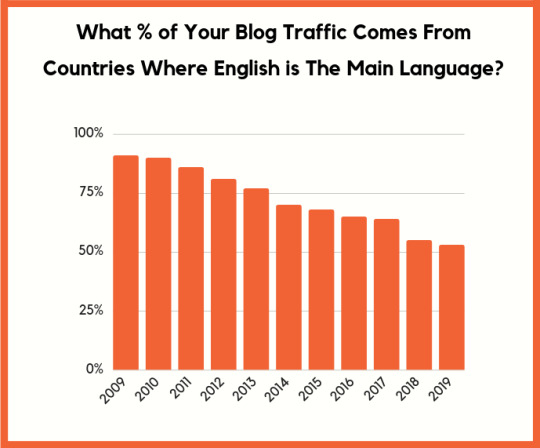
At one point it was 91% but now it has dropped down to 53%. This has also created a trend in which companies are now translating their content to different languages.
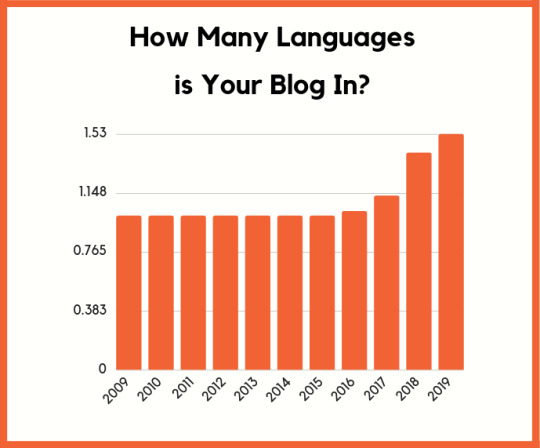
It’s taken a while for companies to adopt the concept of globalization with their digital marketing but now it’s catching on fast.
I was able to ride the trend before most people because I got pushed to do so by a Google employee. It was the best marketing advice and it seems to be true for pretty much every blogger out there.
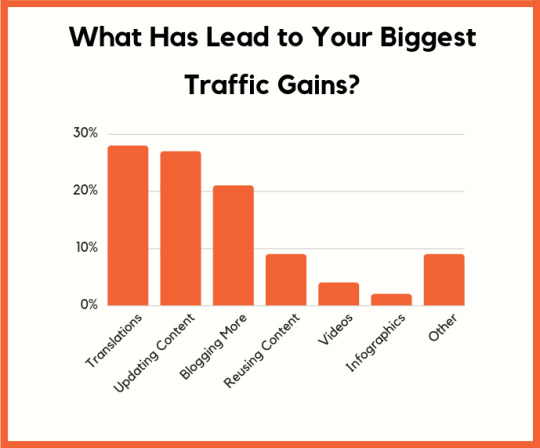
As you can see from the chart above, the biggest traffic gains content marketers are currently getting are from translating their content into multiple languages.
The second biggest gain is coming from updating old content. Content marketing is no longer a game of cranking out hundreds of articles a month. If you want to continually do well, you have to maintain and keep your old content up to date.
When you are building out your content marketing team, focus 50% of their effort on updating old content.
Move over WordPress
The last biggest trend is WordPress isn’t the only content player these days. If you are going to write a blog post, might as well get the most traffic by placing it everywhere.
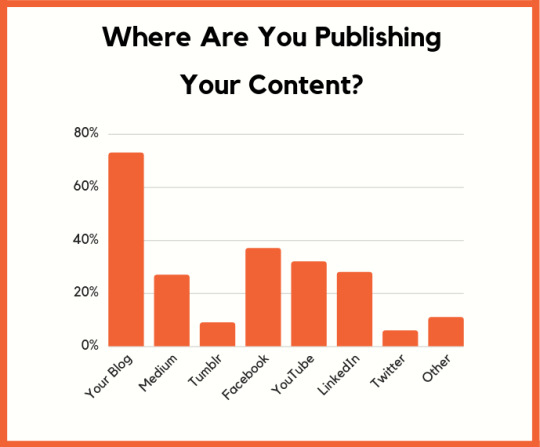
Medium and Tumblr are also great for content. Remember, Google doesn’t penalize for duplicate content. There is nothing wrong with putting content on your blog and then publishing it on Medium and Tumblr a week later.
You can do the same with the social shares… in addition to sharing your content on Facebook, you can publish your whole post a week later on Facebook.
And if you are creating video and audio content you can upload them to Facebook, LinkedIn, YouTube, Instagram and any other platform that will accept it.
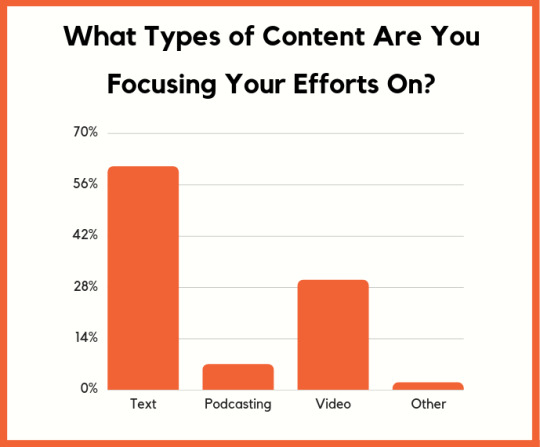
You’ll see huge growth in video and audio content over the next few years.
Facebook, YouTube, and every major platform want their slice of the television market.
Because of that, their algorithms are acting more favorable to content types that keep people on their platform and engaged for hours… hence, you need to expand outside of just text-based content.
It’s also why I’m big on YouTube right now. It diversifies your traffic sources in case you get hit by a Google algorithm change.
Conclusion
If you are going to take one thing from the charts above, you need to focus on translating your content to other languages as it isn’t as competitive.
In addition to that, you need to focus on creating video and audio-based content. Videos have already starting to take off, podcasting isn’t there yet, but it will within the next few years.
I would also tell you to blog, but you probably already have one. 😉
What other content marketing trends have you noticed?
The post 17 Charts That Show Where Content Marketing is Heading appeared first on Neil Patel.
from DIYS https://ift.tt/2UGWDPC
0 notes
Text
6 Tips for Building an SEO + UX-Minded Main Navigation by @joshuacmccoy
Let’s take a look at a few key considerations when building an SEO and UX-minded main navigation.
The post 6 Tips for Building an SEO + UX-Minded Main Navigation by @joshuacmccoy appeared first on Search Engine Journal.
from DIYS https://ift.tt/2Tb7Czm
0 notes
Text
5 Reasons You MUST Spend Money Outside of PPC by @PPCKirk
Here are five reasons why you should be alarmed if your client's business rests solely on PPC.
The post 5 Reasons You MUST Spend Money Outside of PPC by @PPCKirk appeared first on Search Engine Journal.
from DIYS https://ift.tt/2Fl22H6
0 notes
Text
How to Rank on Page 1 of Google FAST (In-Depth Case Study)

Today you’re going to see one of my favorite SEO strategies in action.
(“Guestographics”)
Specifically, I’ll show you how Perrin used this technique hit Google’s first page for a bunch of his target keywords.
Let’s dive right in.
The Guestographic Method:
An SEO Strategy That Gets Results
Guestographics work for one simple reason:
They make your content MUCH easier to share.
I published a post a while back that outlines the entire process: How to Get Backlinks With Guestographics.
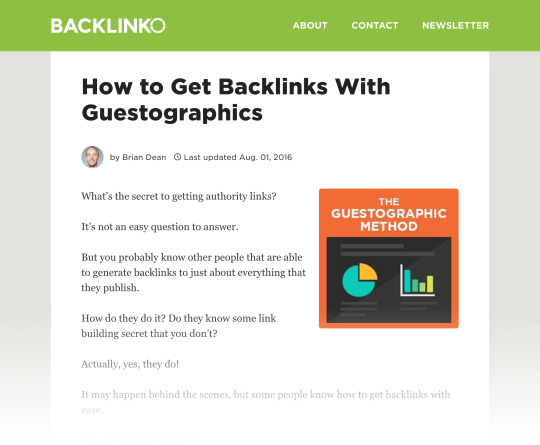
So if you haven’t read that post, go check it out.
In that post I reveal how The Guestographic Method increased my organic traffic by more than 175%:
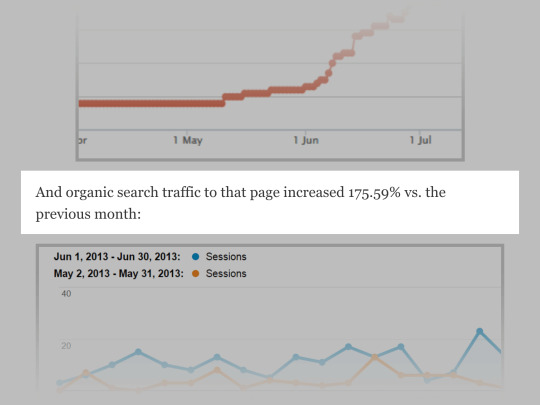
And Guestographics are one reason that Backlinko ranks on the first page for “on page SEO”:

Does this sound like something you’d like to try?
Keep reading…
How Perrin and David Used Guestographics to Skyrocket Their Rankings (And Traffic)
I just showed you how well Guestographics worked for me.
Now it’s time to reveal Perrin and David’s results.
First up, we have Perrin Carrell.
Perrin recently launched a pet blog called HerePup.
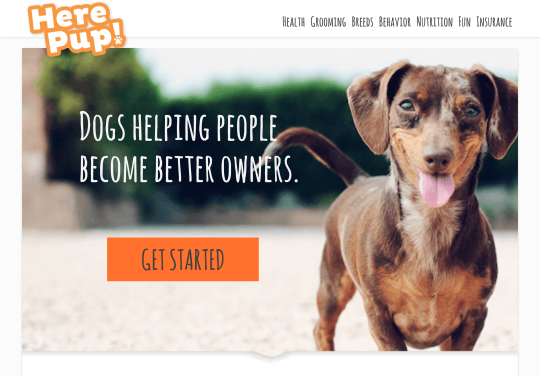
Why did Perrin make this blog?
Well, a few months back Perrin picked up a cute little black puppy from an animal shelter (Chewie).

Like most new dog owners, Perrin searched for the best dog food for Chewie…
…but he didn’t find any content that blew him away.
That’s when Perrin realized that he had a HUGE opportunity staring him in the face:
There aren’t any dog blogs with mind-blowing content. Why not make the first one?
In Perrin’s own words:

“I saw a few smaller blogs ranking for low-competition keywords. I thought I could top what they were doing. I also noticed that authoritative pet blogs were getting insane traffic. Even though it was going to be really tough to beat these bigger sites, that showed me that the ceiling in this niche was really high.”
Perrin Carrell

After dozens of late-night writing sessions, Perrin’s site went live:

(Note: Perrin’s original name for the blog was Chewie Says. But he recently changed it to Here Pup)
That’s the good news.
The bad news? The dog blog space is dominated by a handful of massive authority sites.
That means that Perrin is going toe-to-toe with mega-sites like PetMD.com and Cesar “The Dog Whisperer” Millan.
You could even say that it’s a dog-eat-dog world (sorry, I couldn’t resist 😀 ).
To have a fighting chance against these massive authority sites, Perrin had two options:
Option #1: He could grind away on his blog, publish on a set schedule, and HOPE he got traffic (“The Publish and Pray Approach”).
Option #2: He could create (and promote) a few pieces of amazing content.
Fortunately for Perrin and his new blog, he pulled the trigger on option #2.
And he decided to kick things off with Guestographics.
How did it go?
Guestographics boosted his organic search engine traffic by 963% in just 6-weeks:
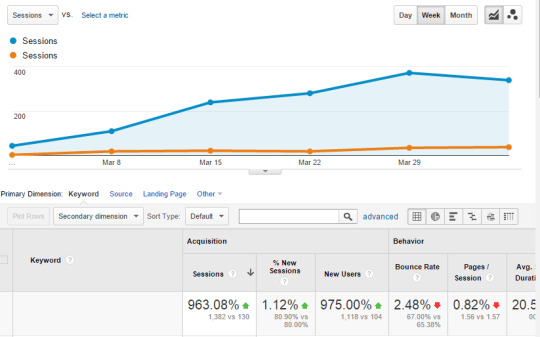
And thanks to placements on a handful of popular pet blogs…

…and The Huffington Post…
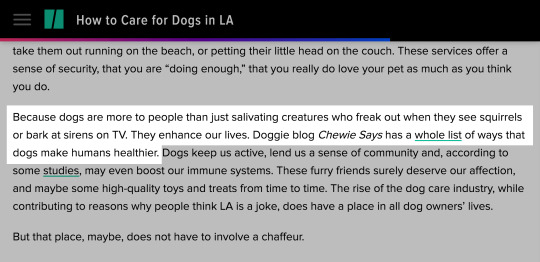
…he also funneled over 1000 targeted referral visitors to his site:

Not bad for a brand new blog.
Note: His secret was NOT a $10,000 infographic. As you’ll see in a minute, design had very little to do with Perrin’s success.
With that out of the way, it’s time for me to walk you through the step-by-step process.
Step 1: Create and Publish a (Really Good) Infographic
Here’s the deal:
Despite what most “content marketing gurus” would have you believe, design plays a VERY small part in an infographic’s success.
In fact, choosing the right topic is 90% of the game.
And that’s where Perrin’s infographic — 22 Ways Dogs Make Humans Healthier — hits a home run:

Sure, his infographic looks really nice.
But it wouldn’t have done NEARLY as well without a topic that dog lovers cared about.
Now:
Perrin had a hunch that dog owners would want to learn that Mr. Fluffy Pants improves their health.
So he searched for “dogs and human health”.

And he came across this slideshow from WebMD ranking on the first page:

(Yes, that’s really what it looks like)
As Perrin puts it:

“That’s not a good article. It’s just fun facts with cute blurbs. There’s no design or research to speak of. I knew I could do it better, and one of the ways I wanted to improve it was to make an infographic.”
Perrin Carrell

Even though the WebMD page leaves A LOT to be desired, it attracted backlinks from over 300 referring domains:

In other words, Perrin saw that there was proven demand for content about “ways that pets improve human health”.
But not just any information…
…demand for visual content.
So Perrin decided to create an infographic around that proven topic.
First, he spent a day researching content for the infographic.
Then he hired a freelance designer to take his list of bullet points…
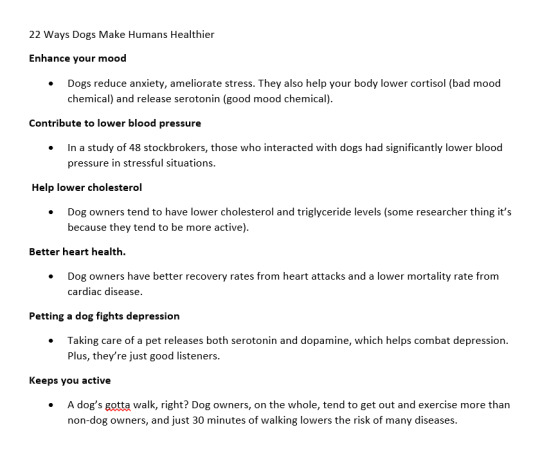
…and turn it into a professional infographic.

Looks nice, right?
As you probably know, publishing something valuable isn’t enough to generate quality backlinks and targeted traffic.
If you’re serious about getting results from your content, you need to strategically promote it.
Which leads us to step #2…
Step 2: Find People That Are Interested In Your Infographic
Once your infographic is ready, it’s time to make a list of people that might want to check it out.
The easiest way to do that? Search for keywords that describe your infographic’s topic.
For example:
Let’s say that you just published an infographic about the Paleo Diet.
You’d Google keywords like “Paleo diet”, “Paleo diet recipes”, “what is the Paleo Diet?” etc.
And Google will show you a list of blogs that tend to cover that topic:

You can even use Google Suggest to get even more keyword ideas:

Here’s how Perrin found his Guestographic prospects:
Like I just outlined, Perrin searched in Google using keywords like “pets and health.”
But he didn’t stop there…
He also searched for keywords like “top 50 dog blogs”.

These “best of” keywords hooked Perrin up with hand-curated lists of popular pet blogs:
from DIYS https://ift.tt/2O8ALdq
0 notes
Text
Google Florida 2.0 Algorithm Update: Early Observations
It has been a while since Google has had a major algorithm update.
They recently announced one which began on the 12th of March.
This week, we released a broad core algorithm update, as we do several times per year. Our guidance about such updates remains as we’ve covered before. Please see these tweets for more about that:https://t.co/uPlEdSLHoXhttps://t.co/tmfQkhdjPL— Google SearchLiaison (@searchliaison) March 13, 2019
What changed?
It appears multiple things did.
When Google rolled out the original version of Penguin on April 24, 2012 (primarily focused on link spam) they also rolled out an update to an on-page spam classifier for misdirection.
And, over time, it was quite common for Panda & Penguin updates to be sandwiched together.
If you were Google & had the ability to look under the hood to see why things changed, you would probably want to obfuscate any major update by changing multiple things at once to make reverse engineering the change much harder.
Anyone who operates a single website (& lacks the ability to look under the hood) will have almost no clue about what changed or how to adjust with the algorithms.
In the most recent algorithm update some sites which were penalized in prior "quality" updates have recovered.
Though many of those recoveries are only partial.
Many SEO blogs will publish articles about how they cracked the code on the latest update by publishing charts like the first one without publishing that second chart showing the broader context.
The first penalty any website receives might be the first of a series of penalties.
If Google smokes your site & it does not cause a PR incident & nobody really cares that you are gone, then there is a very good chance things will go from bad to worse to worser to worsterest, technically speaking.
“In this age, in this country, public sentiment is everything. With it, nothing can fail; against it, nothing can succeed. Whoever molds public sentiment goes deeper than he who enacts statutes, or pronounces judicial decisions.” - Abraham Lincoln
Absent effort & investment to evolve FASTER than the broader web, sites which are hit with one penalty will often further accumulate other penalties. It is like compound interest working in reverse - a pile of algorithmic debt which must be dug out of before the bleeding stops.
Further, many recoveries may be nothing more than a fleeting invitation to false hope. To pour more resources into a site that is struggling in an apparent death loop.
The above site which had its first positive algorithmic response in a couple years achieved that in part by heavily de-monetizing. After the algorithm updates already demonetized the website over 90%, what harm was there in removing 90% of what remained to see how it would react? So now it will get more traffic (at least for a while) but then what exactly is the traffic worth to a site that has no revenue engine tied to it?
That is ultimately the hard part. Obtaining a stable stream of traffic while monetizing at a decent yield, without the monetizing efforts leading to the traffic disappearing.
A buddy who owns the above site was working on link cleanup & content improvement on & off for about a half year with no results. Each month was a little worse than the prior month. It was only after I told him to remove the aggressive ads a few months back that he likely had any chance of seeing any sort of traffic recovery. Now he at least has a pulse of traffic & can look into lighter touch means of monetization.
If a site is consistently penalized then the problem might not be an algorithmic false positive, but rather the business model of the site.
The more something looks like eHow the more fickle Google's algorithmic with receive it.
Google does not like websites that sit at the end of the value chain & extract profits without having to bear far greater risk & expense earlier into the cycle.
Thin rewrites, largely speaking, don't add value to the ecosystem. Doorway pages don't either. And something that was propped up by a bunch of keyword-rich low-quality links is (in most cases) probably genuinely lacking in some other aspect.
Generally speaking, Google would like themselves to be the entity at the end of the value chain extracting excess profits from markets.
This is the purpose of the knowledge graph & featured snippets. To allow the results to answer the most basic queries without third party publishers getting anything. The knowledge graph serve as a floating vertical that eat an increasing share of the value chain & force publishers to move higher up the funnel & publish more differentiated content.
As Google adds features to the search results (flight price trends, a hotel booking service on the day AirBNB announced they acquired HotelTonight, ecommerce product purchase on Google, shoppable image ads just ahead of the Pinterest IPO, etc.) it forces other players in the value chain to consolidate (Expedia owns Orbitz, Travelocity, Hotwire & a bunch of other sites) or add greater value to remain a differentiated & sought after destination (travel review site TripAdvisor was crushed by the shift to mobile & the inability to monetize mobile traffic, so they eventually had to shift away from being exclusively a reviews site to offer event & hotel booking features to remain relevant).
It is never easy changing a successful & profitable business model, but it is even harder to intentionally reduce revenues further or spend aggressively to improve quality AFTER income has fallen 50% or more.
Some people do the opposite & make up for a revenue shortfall by publishing more lower end content at an ever faster rate and/or increasing ad load. Either of which typically makes their user engagement metrics worse while making their site less differentiated & more likely to receive additional bonus penalties to drive traffic even lower.
In some ways I think the ability for a site to survive & remain though a penalty is itself a quality signal for Google.
Some sites which are overly reliant on search & have no external sources of traffic are ultimately sites which tried to behave too similarly to the monopoly that ultimately displaced them. And over time the tech monopolies are growing more powerful as the ecosystem around them burns down:
If you had to choose a date for when the internet died, it would be in the year 2014. Before then, traffic to websites came from many sources, and the web was a lively ecosystem. But beginning in 2014, more than half of all traffic began coming from just two sources: Facebook and Google. Today, over 70 percent of traffic is dominated by those two platforms.
Businesses which have sustainable profit margins & slack (in terms of management time & resources to deploy) can better cope with algorithmic changes & change with the market.
Over the past half decade or so there have been multiple changes that drastically shifted the online publishing landscape:
the shift to mobile, which both offers publishers lower ad yields while making the central ad networks more ad heavy in a way that reduces traffic to third party sites
the rise of the knowledge graph & featured snippets which often mean publishers remain uncompensated for their work
higher ad loads which also lower organic reach (on both search & social channels)
the rise of programmatic advertising, which further gutted display ad CPMs
the rise of ad blockers
increasing algorithmic uncertainty & a higher barrier to entry
Each one of the above could take a double digit percent out of a site's revenues, particularly if a site was reliant on display ads. Add them together and a website which was not even algorithmically penalized could still see a 60%+ decline in revenues. Mix in a penalty and that decline can chop a zero or two off the total revenues.
Businesses with lower margins can try to offset declines with increased ad spending, but that only works if you are not in a market with 2 & 20 VC fueled competition:
Startups spend almost 40 cents of every VC dollar on Google, Facebook, and Amazon. We don’t necessarily know which channels they will choose or the particularities of how they will spend money on user acquisition, but we do know more or less what’s going to happen. Advertising spend in tech has become an arms race: fresh tactics go stale in months, and customer acquisition costs keep rising. In a world where only one company thinks this way, or where one business is executing at a level above everyone else - like Facebook in its time - this tactic is extremely effective. However, when everyone is acting this way, the industry collectively becomes an accelerating treadmill. Ad impressions and click-throughs get bid up to outrageous prices by startups flush with venture money, and prospective users demand more and more subsidized products to gain their initial attention. The dynamics we’ve entered is, in many ways, creating a dangerous, high stakes Ponzi scheme.
And sometimes the platform claws back a second or third bite of the apple. Amazon.com charges merchants for fulfillment, warehousing, transaction based fees, etc. And they've pushed hard into launching hundreds of private label brands which pollute the interface & force brands to buy ads even on their own branded keyword terms.
They've recently jumped the shark by adding a bonus feature where even when a brand paid Amazon to send traffic to their listing, Amazon would insert a spam popover offering a cheaper private label branded product:
Amazon.com tested a pop-up feature on its app that in some instances pitched its private-label goods on rivals’ product pages, an experiment that shows the e-commerce giant’s aggressiveness in hawking lower-priced products including its own house brands. The recent experiment, conducted in Amazon’s mobile app, went a step further than the display ads that commonly appear within search results and product pages. This test pushed pop-up windows that took over much of a product page, forcing customers to either click through to the lower-cost Amazon products or dismiss them before continuing to shop. ... When a customer using Amazon’s mobile app searched for “AAA batteries,” for example, the first link was a sponsored listing from Energizer Holdings Inc. After clicking on the listing, a pop-up window appeared, offering less expensive AmazonBasics AAA batteries."
Buying those Amazon ads was quite literally subsidizing a direct competitor pushing you into irrelevance.
As the market caps of big tech companies climb they need to be more predatious to grow into the valuations & retain employees with stock options at an ever-increasing price.
They've created bubbles in their own backyards where each raise requires another. Teachers either drive hours to work or live in houses subsidized by loans from the tech monopolies that get a piece of the upside (provided they can keep their own bubbles inflated).
"It is an uncommon arrangement — employer as landlord — that is starting to catch on elsewhere as school employees say they cannot afford to live comfortably in regions awash in tech dollars. ... Holly Gonzalez, 34, a kindergarten teacher in East San Jose, and her husband, Daniel, a school district I.T. specialist, were able to buy a three-bedroom apartment for $610,000 this summer with help from their parents and from Landed. When they sell the home, they will owe Landed 25 percent of any gain in its value. The company is financed partly by the Chan Zuckerberg Initiative, Mark Zuckerberg’s charitable arm."
The above sort of dynamics have some claiming peak California:
The cycle further benefits from the Alchian-Allen effect: agglomerating industries have higher productivity, which raises the cost of living and prices out other industries, raising concentration over time. ... Since startups raise the variance within whatever industry they’re started in, the natural constituency for them is someone who doesn’t have capital deployed in the industry. If you’re an asset owner, you want low volatility. ... Historically, startups have created a constant supply of volatility for tech companies; the next generation is always cannibalizing the previous one. So chip companies in the 1970s created the PC companies of the 80s, but PC companies sourced cheaper and cheaper chips, commoditizing the product until Intel managed to fight back. Meanwhile, the OS turned PCs into a commodity, then search engines and social media turned the OS into a commodity, and presumably this process will continue indefinitely. ... As long as higher rents raise the cost of starting a pre-revenue company, fewer people will join them, so more people will join established companies, where they’ll earn market salaries and continue to push up rents. And one of the things they’ll do there is optimize ad loads, which places another tax on startups. More dangerously, this is an incremental tax on growth rather than a fixed tax on headcount, so it puts pressure on out-year valuations, not just upfront cash flow.
If you live hundreds of miles away the tech companies may have no impact on your rental or purchase price, but you can't really control the algorithms or the ecosystem.
All you can really control is your mindset & ensuring you have optionality baked into your business model.
If you are debt-levered you have little to no optionality. Savings give you optionality. Savings allow you to run at a loss for a period of time while also investing in improving your site and perhaps having a few other sites in other markets.
If you operate a single website that is heavily reliant on a third party for distribution then you have little to no optionality. If you have multiple projects that enables you to shift your attention toward working on whatever is going up and to the right while letting anything that is failing pass time without becoming overly reliant on something you can't change. This is why it often makes sense for a brand merchant to operate their own ecommerce website even if 90% of their sales come from Amazon. It gives you optionality should the tech monopoly become abusive or otherwise harm you (even if the intent was rather than outright misanthropic).
As the update ensues Google will collect more data with how users interact with the result set & determine how to weight different signals, along with re-scoring sites that recovered based on the new engagement data.
Recently a Bing engineer named Frédéric Dubut described how they score relevancy signals used in updates
As early as 2005, we used neural networks to power our search engine and you can still find rare pictures of Satya Nadella, VP of Search and Advertising at the time, showcasing our web ranking advances. ... The “training” process of a machine learning model is generally iterative (and all automated). At each step, the model is tweaking the weight of each feature in the direction where it expects to decrease the error the most. After each step, the algorithm remeasures the rating of all the SERPs (based on the known URL/query pair ratings) to evaluate how it’s doing. Rinse and repeat.
That same process is ongoing with Google now & in the coming weeks there'll be the next phase of the current update.
So far it looks like some quality-based re-scoring was done & some sites which were overly reliant on anchor text got clipped. On the back end of the update there'll be another quality-based re-scoring, but the sites that were hit for excessive manipulation of anchor text via link building efforts will likely remain penalized for a good chunk of time.
Categories:
google
from DIYS https://ift.tt/2CpAYUZ
0 notes
Text
Twitter to Introduce a ‘Subscribe to Conversation’ Feature by @MattGSouthern
Twitter is working on a feature that will allow users to follow specific threads with a 'subscribe to conversation' button.
The post Twitter to Introduce a ‘Subscribe to Conversation’ Feature by @MattGSouthern appeared first on Search Engine Journal.
from DIYS https://ift.tt/2TRKF8D
0 notes
Text
5 Types of Stories Brands & Marketers Should Be Using by @https://twitter.com/seocopychick
Here are five story types that you can use to broaden reach and draw in new clients or customers.
The post 5 Types of Stories Brands & Marketers Should Be Using by @https://twitter.com/seocopychick appeared first on Search Engine Journal.
from DIYS https://ift.tt/2TbGU9G
0 notes
Text
Data Confirms Why March 2019 Update Feels Like a Rollback by @martinibuster
New data offers explanation why March 2019 Core Update feels like a rollback.
The post Data Confirms Why March 2019 Update Feels Like a Rollback by @martinibuster appeared first on Search Engine Journal.
from DIYS https://ift.tt/2O7ee0M
0 notes
Text
How To Force Q&A On a GMB Page That Doesn’t Have It
Here’s a stupid little GMB Q&A thing I figured out yesterday I thought you all might enjoy.
I was asked by mi nuevo amigo, Ruben Coll Molina of PA Digital in Spain, what is the event that triggers the Q&A functionality in a GMB profile? Ruben had found that some of their SMB customers did not have the functionality. He sent me to this SERP for “nouvelle couquette”, a clothing store in Torrent, Spain. At the time, their GMB did not display the “Ask a Question” module like this:
Ok, I doctored it. Of course I forgot to take a “before” screenshot, but trust me, I’m an SEO consultant…
Anyhow, I searched for “women’s clothing stores in Torrent, Spain,” got a local pack then clicked on the “More Places” link and saw Nouvelle Couquette listed in the Google Maps Local Finder, but this time it had the Q&A widget, but no questions had been asked:
On a hunch, using my best 7th grade Spanish, I asked a question:
Ruben answered:
A few seconds later we witnessed El Milagro de Las Preguntas y Respuestas:
Quien es mas macho?
The post How To Force Q&A On a GMB Page That Doesn’t Have It appeared first on Local SEO Guide.
from DIYS https://ift.tt/2CnPnkD
0 notes
Text
Demystifying JavaScript: Tips & Tools for Testing Rendering by @rachellcostello
Here's how to test whether the JavaScript on your website renders properly and some tools for testing and debugging JavaScript.
The post Demystifying JavaScript: Tips & Tools for Testing Rendering by @rachellcostello appeared first on Search Engine Journal.
from DIYS https://ift.tt/2T9VcaS
0 notes
Text
Real Estate Link Building: 3 of the Best Tactics by @DholakiyaPratik
Here's how to approach outreach and some specific real estate link building tactics that can help boost your search visibility.
The post Real Estate Link Building: 3 of the Best Tactics by @DholakiyaPratik appeared first on Search Engine Journal.
from DIYS https://ift.tt/2HkpMgI
0 notes
Text
13 Professional Networking Alternatives to LinkedIn by @hoffman8
Looking for options to expand your professional network aside from LinkedIn? Check out these 13 platforms.
The post 13 Professional Networking Alternatives to LinkedIn by @hoffman8 appeared first on Search Engine Journal.
from DIYS https://ift.tt/2THvmPW
0 notes
Text
Massive Facebook Outage by @martinibuster
Facebook outage affects the ability to share links on posts to news feed.
The post Massive Facebook Outage by @martinibuster appeared first on Search Engine Journal.
from DIYS https://ift.tt/2XVb5pd
0 notes
Text
How to Build Your Own Search Ranking Algorithm with Machine Learning by @CoperniX
Here's how you can build your very own web search ranking algorithm using machine learning.
The post How to Build Your Own Search Ranking Algorithm with Machine Learning by @CoperniX appeared first on Search Engine Journal.
from DIYS https://ift.tt/2T4Oe6W
0 notes
Text
Why You Must Unlearn What You Know About the YouTube Algorithm by @gregjarboe
Here are seven of the most significant findings on YouTube's algorithm that overturn conventional wisdom dramatically.
The post Why You Must Unlearn What You Know About the YouTube Algorithm by @gregjarboe appeared first on Search Engine Journal.
from DIYS https://ift.tt/2O3crK3
0 notes
Text
Your Definitive Guide to Ecommerce Marketing in 2019 [EBOOK] by @lorenbaker
Find out how to organize your ecommerce website navigation, on-page SEO tactics, and best marketing practices for growing your online business with our guide.
The post Your Definitive Guide to Ecommerce Marketing in 2019 [EBOOK] by @lorenbaker appeared first on Search Engine Journal.
from DIYS https://ift.tt/2VNuAhA
0 notes
Text
Over 24 And Thinking About College? You're Not Alone

About 7.6 million adults 25 and over attended college in 2018. Among them are a mother of four, a Navy vet and a grandmother finishing what she started more than four decades ago.
(Image credit: NPR)

from DIYS https://ift.tt/2XRFvsE
0 notes